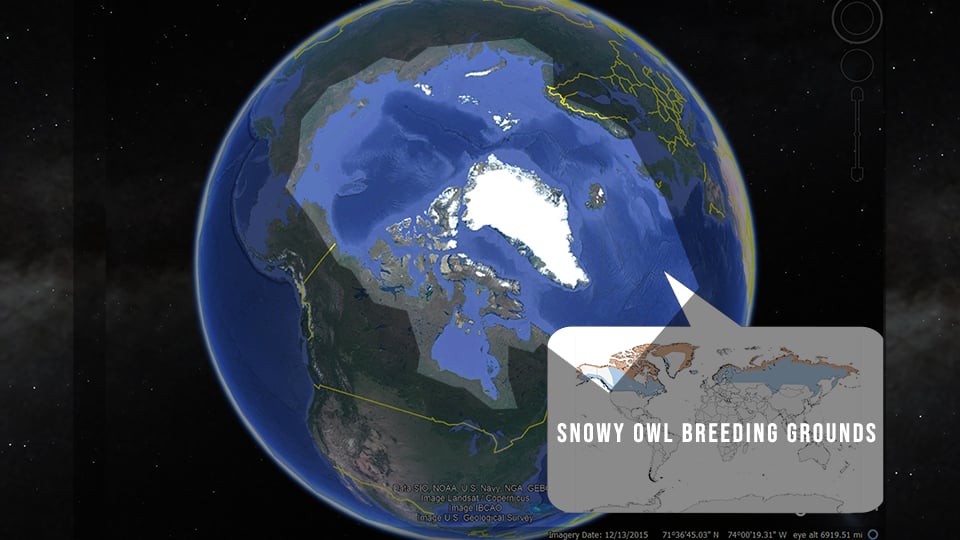We were beyond thrilled to see Snowy Owls on the Flyway in early January. What are they doing here, so far from their arctic home? We think that their irruptions are linked to food availability and successful breeding. Snowy owls prey heavily on lemmings, a stocky, stump-tailed rodent that might be abundant one year and almost impossible to find the next. A good lemming year is usually an excellent year for snowy owl production, which means a lot of competition for newly fledged owlets. An experienced owl can shift to other prey, but competition and food shortages often force younger, inexperienced birds south of their usual range.
Why do young owls often move farther south?
Snowy owls sometimes irrupt in great numbers, but not all age and sex classes end up in the same place. Adult females, at the top of the snowy pecking order, usually stay the farthest north. Adult males move south of adult females, immature females move south of adult males, and immature males, at the bottom of the pecking order, move south of immature females. They are the group most likely to show up far from the arctic – on, say, a frozen Mississippi river lake roughly 2,000 miles south of the place they were born.

Snowy Owl Breeding Range. Information taken from Cornell’s world of birds website: https://birdsoftheworld.org/bow/species/snoowl1/cur/introduction
Why do adult owls stay north? Think lemmings and owlets! A wintering adult owl can support itself on ptarmigan, carrion, or waterfowl, but a pair of nesting owls needs lemmings, and lots of them. Since lemming populations aren’t predictable – lemmings might be wildly abundant or entirely absent in any given year at any given place – female owls prospect for lemming-rich sites every spring. Female owls that stay in or close to the arctic have a better chance of securing a good site, and males have a better chance of securing a mate.
We have seen juvenile females and possibly one adult female on the Flyway. Karla Bloem, the International Owl Center’s Executive Director, has more information in her guest blog: https://www.raptorresource.org/2022/01/10/snowy-owl-faqs-and-information/.
Nomadic Wanderers
Snowy owls are beautiful, but I think their nomadic behavior is the most fascinating thing about them. Competition, food stocks, and genetic programming cause them to wander unpredictably and nest opportunistically: unlike bald eagles, this year’s nest might be 500 miles or more from last year’s nest. They are monogamous for a season but not, as far as we know, for longer: unlike many raptors, snowy owls can’t reunite at a nest site. Although young owls irrupt further south than adults, their wandering behavior isn’t really that different: thriving in one of the world’s harshest environments has taught this species to move.
Thanks to satellite tracking, banding and tagging, researchers have discovered that Snowy Owls can be more faithful to their wintering sites than to their breeding sites. Karla has more about that here: https://www.raptorresource.org/2022/01/10/snowy-owl-faqs-and-information/.
Enjoy snowy owls, rough-legged hawks, northern harriers, and short-eared owls while you can – the days are getting longer, and the slow pulse of northern life will quicken as winter turns to spring. I feel lucky to get a glimpse of these special northern visitors and wish them the very best here and everywhere else they fly!
Did You Know?
Snowy Owl irruptions correlate with large Rough-legged Hawk irruptions. The two nest in similar places and specialize in small rodents, so lean food years for snowies are also lean years for rough-legged hawks. This video from the Flyway shows both: https://youtu.be/64eNY2v33_I.
If you are somewhere north of your mid-forties, you might have learned that lemmings end their lives by jumping into the sea. Nope! Lemming populations rise and fall, but jumping into the sea has nothing to do with it. A little more about them: https://animaldiversity.org/accounts/Lemmus_lemmus/
References
Weidensaul, Scott. Living On the Wind: Across the Hemisphere With Migratory Birds North Point Press, 1999.
Doyle, Frank I., et al. “Seasonal Movements of Female Snowy Owls Breeding in the Western North American Arctic.”
BioOne Complete, Raptor Research Foundation, https://bioone.org/journals/journal-of-raptor-research/volume-51/issue-4/JRR-16-51.1/Seasonal-Movements-of-Female-Snowy-Owls-Breeding-in-the-Western/10.3356/JRR-16-51.1.full?tab=ArticleLink.
Therrien, J.-F., Gauthier, G., Pinaud, D. and Bêty, J. (2014), Irruptive movements and breeding dispersal of snowy owls: a specialized predator exploiting a pulsed resource. J Avian Biol, 45: 536-544. https://doi.org/10.1111/jav.00426
 The Raptor Resource Project
The Raptor Resource Project The Raptor Resource Project
The Raptor Resource Project